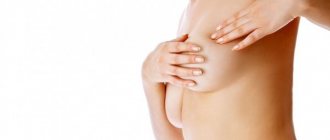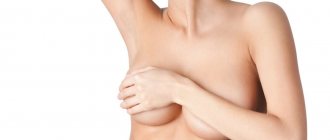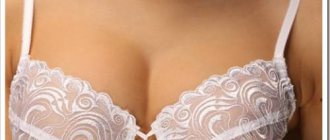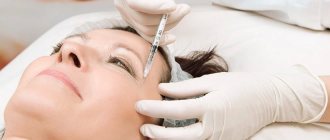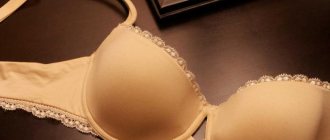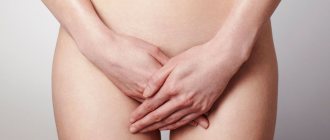Tubular breast is a specific professional term that describes a special shape of the mammary glands. This shape is considered an aesthetic defect: the breast has a distorted outline, for example, in the form of a baby's pacifier - with a wide base, but a narrowed (cone-shaped) main part with an expanded nipple. Often this disorder is accompanied by asymmetry of the mammary glands.
This variant of the structure of the mammary glands does not threaten women’s health. But it may well affect self-confidence and the feeling of one’s own attractiveness. Therefore, correction of tubular breasts in women is intended, first of all, to eliminate the aesthetic problem, significantly improving the psychological state of the patient.
Preparing for surgery
The pathology of the tubular breast has been studied since the 70s of the last century.
It is known that such an anomaly in the development of the mammary glands occurs in one woman out of 50. The formation of tubules is inherited. During the development of the mammary glands (during puberty), rough connective tissue does not allow the breast to develop evenly and growth proceeds exclusively towards the nipple, making the breasts elongated. The main signs of tubular breasts:
- the chest is shaped like a cone;
- areolas are undeveloped;
- breast growth is tracked only towards the nipple;
- flat nipple.
Before the operation, the patient must undergo a medical examination and pass all the necessary tests. A woman visits a mammologist and takes pictures of her breasts so that she can assess the condition of the mammary glands and rule out the presence of cysts or neoplasms. Blood and urine tests are taken to detect inflammation, viruses, and infections.
It is important to monitor blood clotting (before surgery, you should not take medications that affect it). The use of alcohol and drugs is prohibited.
Cost of correction
The cost of the operation may vary depending on the type of tubulation and the severity of the defects.
Approximate prices:
| Type of intervention | Price |
| Mammoplasty (endoprosthetics) | 120,000 – 240,000 rub. (including the cost of prostheses) |
| Periareolar mastopexy | 165,000 – 245,000 (excluding cost of prosthesis) |
| Vertical mastopexy | 210,000 – 220,000 (without implants) |
| Anchor mastopexy | From 240,000 rub. |
The total amount includes the cost of consultation, examination, anesthesia and the implants themselves. If a complex intervention is planned, the patient will need to pay for her hospital stay.
How is the operation performed?
Tubular breast correction is considered one of the most difficult procedures among plastic surgery related to breast correction. An anomaly requires an individual approach, extensive specialist experience and a good understanding of the problem. The main stages of the operation are:
- Incisions of the required size on the areola.
- Reducing the area around the nipple.
- Formation of a pocket for the implant.
- Preparing the implant.
- Installation of a special tube through which blood clots will be released during the postoperative period.
- Applying stitches and putting on compression garments.
Modern equipment allows the operation to be performed quickly and efficiently. During this procedure it is not necessary to use silicone; it is often necessary to reduce the shape of the breast. If the case is advanced, then such an operation is carried out in several stages - to position the implant, you must first install an expander, which will stretch the connective tissue and free up space, creating a pocket.
There are non-invasive methods for correcting tubular breasts, but only plastic surgery can guarantee a 100% correction result. It gives long-lasting results and is characterized by positive changes in breast shape.
Fadin Alexander Sergeevich plastic surgeon, Candidate of Medical Sciences
Tubular breast...
Tubular breasts... or “mushroom season” (a variant of the development of the mammary glands when the breasts have the shape of a cone on a narrow base).
Tubulo-[lat. tubulus (diminutive of tubus) and tubula (diminutive of tuba) tube, tube] a component of compound words meaning: “having the shape of a tube”, “relating to a tube, to tubes”... (Medical Encyclopedia)
It is interesting that the aardvark - a mammal that lives only in Africa since the time of dinosaurs - has no close relatives, except perhaps modern girls with tubular breasts, because even in the name there is a similarity (the Latin name tubulidentata speaks of the uniqueness, in the first case - of the mammary glands, and in the second - the structure of his teeth, they consist of tubes in the very depths of the mouth and grow constantly).
Inspection. Two... uh, “eyes” stared at me in amazement, although these things had nothing in common with eyes... I’m talking about the nipple-areolar complex, as experts correctly call it, but still they were not ordinary, more precisely, they were unusual, they protruded and rose like the towers of a tank or like a soufflé in a baking dish that had risen and crawled out of its boundaries (Surgeons, Remembering the sister of talent, they call this anatomical phenomenon a hernia-like protrusion of the SAH and often compare it with mushrooms). I don’t know if a young girl can get used to such a “miracle.” And, to be honest, there is no mystery in this miracle. Just as there are few people in whom the desire to solve it has awakened... there is only the ability to control the situation, “trained” over the years. Here is a typical “tubular” post on one of the women’s forums:
“Yes, it's terrible. I had this, but in those days there was no Internet and it was impossible to read about this. I always knew that it was some kind of deformity, but the doctors reassured me that as soon as I grew up, everything would change. I cried to my mother - she called me names as best she could and said that I only have men on my mind since I have such an idea and a fixation on this. How can you not think about this when you are teased everywhere - on the beach, in the locker rooms, even your girlfriends were shocked and only sympathized. I couldn’t date boys for a long time; I had a WILD complex. The first man didn’t say anything, but after intimacy I didn’t call or look for meetings myself, because... I understood that there would be no continuation. She married a second man. He always told me that “everything is fine with me, if not for my breasts.” Then I didn’t know that this was some kind of developmental anomaly, I just thought that these breasts were small and terribly shaped. I divorced my husband 10 years later, not because of this, of course. I went to get implants because... I realized that I have a terrible complex, which, unfortunately, has not gone away even with time. The plastic surgeon told me what I actually have. I felt some kind of relief - I always knew that something was wrong with me, but I didn’t know that it was honey. problem. I had correction and implants. And now I simply cannot imagine life without a new breast. It was like I was reborn again. Thank God there is plastic surgery, because there are people for whom it really changes their lives, and not just makes them beautiful.”
Eliminating tubularity and simultaneously increasing breast size and improving its shape is the easiest way to transform the mammary glands from enemies into accomplices - a rare pleasure for surgeons, when the difference “before and after” the operation (both anatomical and emotional) is so great that it destroys all illusions to genetically imposed hopelessness. And so, let's look in detail at “how to cover a volcano with a soup lid”...
Stage 1. Access - trans-areolar, most often with a decrease in the diameter of the areola - indicates a clear intention of the surgeons to take the “bull by the horns”, two circular incisions of different diameters at once (one, internal, the diameter of the future areola agreed with the patient, common views fluctuate in the corridor 3.5-4.5 cm, the second, outer – or healing diameter – is the future place of attachment of the areola) with subsequent de-epidermization of the skin. These two rings form a “marriage union” and will create a couple for life, but more on that a little later...
Stage 2. Formation of... a “pocket” (a generally accepted term that reflects the essence of the process of tissue detachment, however, at this moment it is the surgeons who look like aardvarks with their burrowing limbs). In tailoring, a pocket is a bag sewn into clothing for carrying things; in surgery, the size of the pocket and the “things” that their owner will wear are precisely determined (…tel!-, this is happening more and more often). The process occurs using an electric knife (a special surgical instrument capable of simultaneously cutting tissue and providing hemostasis - cauterizing damaged vessels). The pocket should be formed a little larger and in a layer discussed in advance with the patient (under the gland, or under the muscle, or a combination) or, as French lovers say, floor or level. If you “overdo it” with detachment, you can get the effect of a “thrown olive pit” when installing implants, which, until the capsule is formed (3-6 months), can turn over with the frequency of regular flights of successful airlines (if round implants are chosen, then let them turn). for health, ripening in the forming capsule to the desired condition, and if the surgeon used anatomical implants, then the shape of the breast will periodically perplex the owner, reminiscent of live animated wallpaper (physicists use the very beautiful term “stellar wind bubble” when the solar wind plasma moves from the sun at a certain speed).If, on the contrary, the pocket is small or insufficient for the implant to rest freely, then in the absence of free space on one side and the beginning of the capsule formation processes on the other side, the implant, undergoing natural compression, will be guaranteed to be deformed! And such an implant’s stay in the chest (in power) does not last long (it’s like with the theory of a deformed political state - a political theory about the nature of the USSR and other socialist countries). As a result, complications may occur, most often capsular contracture followed by reoperation - capsulotomy.
Stage 3. Preparation for installation of implants. To ensure conditions of maximum asepsis, before installing implants, surgeons perform a number of “rituals”: treatment of the surgical field, hooks with which the assistant helps to hold the edges of the wound raised with a special solution, and even the introduction of such a solution into the formed pocket. (The surgical field for mammoplasty is an open part of the body from the neck to the abdomen.) Next, the surgeons change the gloves to new, “clean” ones. And here I will try to digress and speak out. No surgical achievement that I have ever seen or performed that is of obvious value has been achieved without labor and numerous observations. And if surgeons change gloves before inserting implants, then this is necessary!, verified! period, but my irrepressible suspicion and doubtful character indicate the intangibility of the advantages of this replacement, because if we assume that the gloves in which the previous part was performed, the operations were “unclean,” then hand in hand with this assumption go potential infection and the future inflammation. (However, obvious evidence of postoperative statistics suggests the opposite - inflammation after mammoplasty is extremely rare, no more than one in 1000 cases.) If, as I would like to believe, the surgical field is clean and the surgeon did not use gloves to touch the unwashed parts of the patient’s body and other “dirty” areas , then the procedure in terms of improving the “epidemiological regime” looks quite harmless, but pointless. However, we started with the idea that there must be meaning. It seems to me that the procedure for replacing gloves rather reflects our internal psychological state and gives us the opportunity to do everything! to prevent inflammation, and also helps to switch between stages and look quite graceful (office exercise option!).
Stage 4. Introduction of implants. It usually takes a few seconds, but sometimes turns into a real "terrero", one of the types of wrestling of the Canary Islands, where participants fight in a sand circle, pushing and forcing the opponent to touch the sand with any part of the body other than the feet. This happens when the length of the access incision is insufficient. After the implants are inserted, a drainage is installed - a narrow tube with a vacuum bulb at the end, through which, in the first day or two, blood clots remaining in the wound, etc., are released.) It is interesting that modern car headlights use the same technology, popularly called “drainage” - curved drainage tubes at the bottom of the headlights to remove condensation “outside”.
Stage 5. Suturing the gland tissue and wound edges. To apply deep internal sutures, with which the surgeon brings the edges of the gland together, an absorbable material is usually used, most often vicryl (a synthetic substitute for catgut, a multi-filament suture material, the strength of which varies depending on the time spent in the wound - 65% by the 14th day, 40% by the 21st , complete resorption occurs after 56-70 days). Leather stitching is “multi-level”. After preliminary marking (reminiscent of children drawing watermelons or sun rays), and using one of the generally accepted methods (previously sewed according to Benelli - a circular suture with non-absorbable material, now more often according to Hammand, the principle is the same, but with one fundamental difference - the distribution of the outer diameter when stitching with the bottom it happens evenly and according to the markings). The most commonly used thread is Gortex (a monofilament, non-absorbable suture material made of polytetrafluoroethylene). The characteristics of this material are ideal for this suture: it is durable, non-absorbable and glides easily through the dermis. When this suture is pulled together, the skin of a large diameter is collected, and the tied suture knot must be immersed deep under the dermis to avoid its postoperative appearance in the surgical wound. Monosof is another non-absorbable suture option made from polyamide, a variant of nylon.
The final stage of suturing is a cosmetic one, as they say, or an intradermal suture, capable of adapting the edges of the wound as tightly as possible (monocryl is used - a synthetic monofilament that absorbs within 21 days). Tetracycline ointment will protect against both gram-positive and gram-negative flora and is applied before putting on compression garments.
Choosing an implant
Tubular breasts are corrected using round and anatomical implants. The shape of the prosthesis is selected by a specialist based on the proportions of the patient’s body and other features.
The anatomical implant is ideal for the most natural result. Well suited for thin-boned girls with elastic skin. The contours and curves of the chest are smooth and natural. Round prostheses give the breast a “doll-like” volume, as they fill the upper section and create a raised bust. Such prostheses are selected for women who have enough of their own tissue.
Experts recommend choosing implants based on the width of the chest and the size of the base of the breast.
Is it possible to correct the tubular shape of the mammary glands without surgery?
How to correct the tubular shape of the mammary glands without surgery? This question torments more than one girl. Many are sure that exercise, good nutrition and a healthy lifestyle can correct everything. Alas, this does not apply to tubularity of the mammary glands.
With the help of physical exercises you can only pump up the pectoral muscles, which will slightly raise the soft tissues.
To completely change the shape of the breast, nothing better than plastic surgery has yet been invented. Various conservative methods (massage, swimming, compresses) do not give any effect.
Prosthetics
The prosthesis is installed in two projections. The upper part is placed under the pectoralis major muscle, the lower part under the mammary gland. To do this, the surgeon makes an incision along the border of the areola and breast tissue. The skin flaps are moved aside, the tissues that interfere with the development of the glands are excised. A prosthesis is inserted into the formed pocket, after which the remaining blood is sucked out, the internal tissue is stretched and stitched, then cosmetic stitches are applied.
If the breast is small and the elasticity of the skin is insufficient, an expander is placed in the cavity obtained after excision, which must be regularly filled with solution. This affects the gradual, and most importantly, painless increase in the volume of the gland. This process takes from 6 to 8 months.
Clinical forms and degrees of tubularity
First degree
The growth of the mammary gland is hampered in the middle and lower zone. The tissue deficiency is mild, the breasts are raised upward, the areola has no defects. Often there is no need for surgical correction.
Second degree
There is a significant lack of tissue in the lower section. The breast is displaced downward, the nipple is flattened.
Third degree
A sheath of connective fibers is formed in the mammary gland, which narrows its base and prevents growth. There is a noticeable deficiency of adipose and glandular tissue. Growth can only go towards the nipple, so the areola area expands and an areolar hernia is formed.
Rehabilitation
Recovery after surgery takes a long period of time. It will take about six months for the tubular breast to acquire a natural and symmetrical appearance and for the hematomas and swelling to subside. Only after 6 months can the final result be assessed.
In order not to be disappointed with the result of the operation six months later, the patient must strictly adhere to the recommendations of her doctor:
- observe a two-week ban on alcohol and sex;
- for a month do not perform physical exercise, avoid exertion, do not carry heavy objects weighing more than 3 kg and do not bend forward;
- for the first two weeks sleep only on your back, then you can turn over on your side and only after a month - on your stomach;
- shower and bath - only after permission from the plastic surgeon;
- a ban on saunas and steam baths for two months, and a ban on tanning for three months.
For four weeks after surgery, the patient is required to wear special compression garments. It can be removed only with the permission of the plastic surgeon, for no more than one to two hours a day. After this, they switch to a support bra with underwire.
Rehabilitation period after plastic surgery
If the operation was successful, the patient is discharged 24 hours after surgery. During this time, specialists will once again examine the woman and identify possible complications. After discharge, you must follow a number of recommendations to speed up the wound healing process.
You can’t spend a lot of time lying down; it’s better to rest while sitting or reclining. Food can be taken no later than 5 hours after surgery, and water - after 3 hours. Cold compresses will help relieve pain.
After mammoplasty, it is recommended to rest sitting or reclining
You can take a shower on the 5th day after surgery. The seams are pre-sealed with adhesive tape. You cannot wash your hair yourself : for 30 days you must limit your hand movements.
The bath is taken 6 weeks after surgery. In the first 7-10 days after plastic surgery, the patient should take analgesics and anti-inflammatory medications. During this period, the risk of side effects is high. Diarrhea or constipation usually goes away on its own.
Sutures are removed 14-16 days after plastic surgery. It is recommended to abstain from sports and intimate relationships for 10-14 days. People return to physical activity gradually, 30-35 days after plastic surgery. It is strictly forbidden to consume alcohol and tobacco products for 45-60 days after surgery.
Symptoms and complications of pathology
Tubular breasts are identified during an external examination of the patient. The mammary glands can be cylindrical or cone-shaped. Narrowing of the base of the organ leads to prolapse of the gland (ptosis). The areolas are enlarged, underdeveloped, and their size does not correspond to the patient’s age. The nipple is retracted, flattened, and may have an abnormal structure. When an areolar hernia forms, the nipple-areolar complex protrudes.
Women with tubular breasts do not feel discomfort or pain. They may have difficulty feeding the baby due to the fact that little milk is produced in the breast due to a decrease in the volume of glandular tissue. If the nipple-areolar complex is disturbed, the baby cannot latch onto the breast correctly and swallows air. For this reason, milk production is further reduced.
Organic complications of tubular breasts do not occur in the absence of treatment. An aesthetic defect sometimes causes mental balance disorders. Patients may develop an inferiority complex or develop a neurotic state. After surgery, hematomas may form, the surgical wound may become infected, and a rough scar may form.



